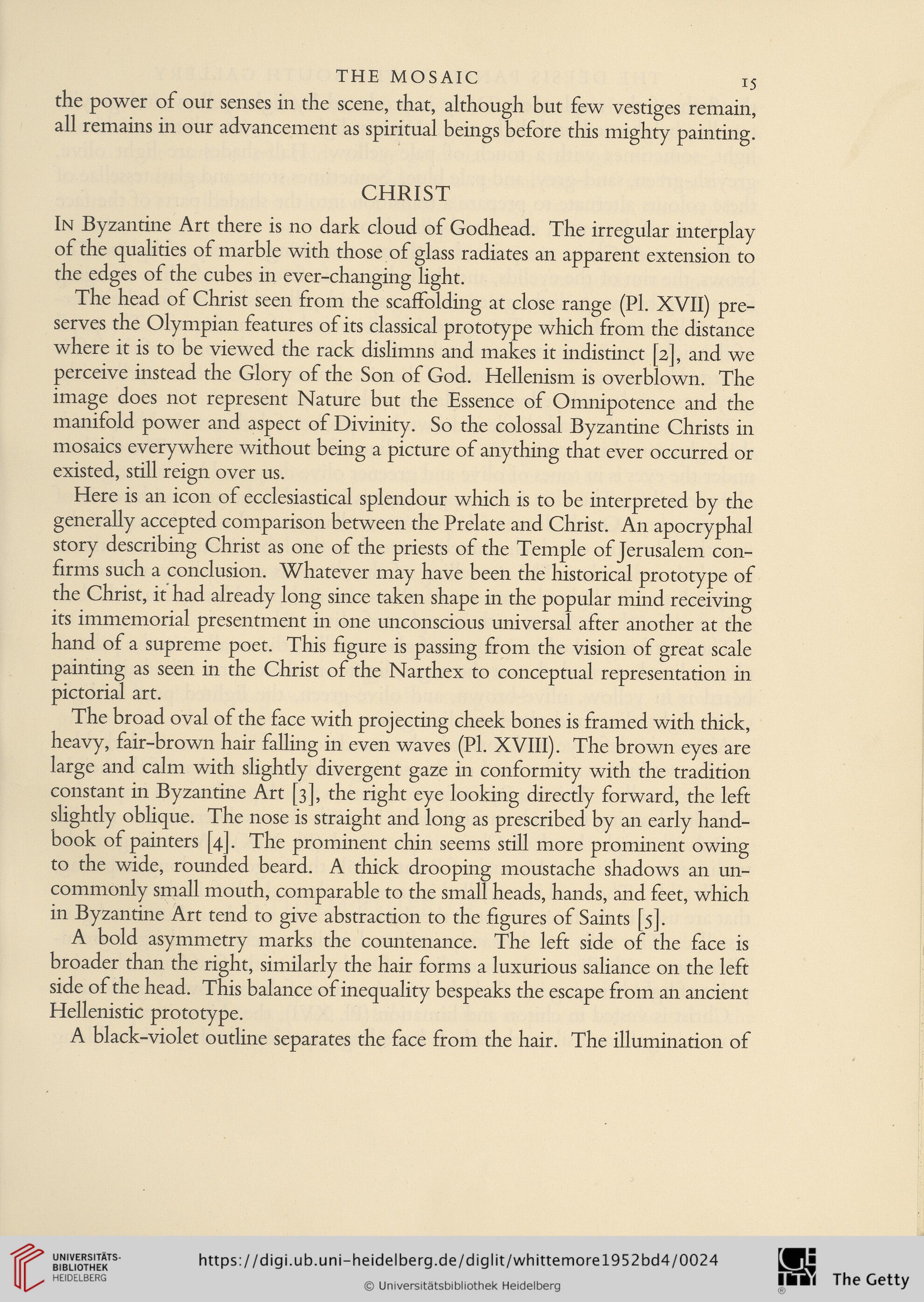THE MOSAIC 15
the power of our senses in the scene, that, although but few vestiges remain,
all remains in our advancement as spiritual beings before this mighty painting.
CHRIST
In Byzantine Art there is no dark cloud of Godhead. The irregular interplay
of the qualities of marble with those of glass radiates an apparent extension to
the edges of the cubes in ever-changing light.
The head of Christ seen from the scaffolding at close range (Pl. XVII) pre-
serves the Olympian features of its classical prototype which from the distance
where it is to be viewed the rack dislimns and makes it indistinct [2], and we
perceive instead the Glory of the Son of God. Hellenism is overblown. The
image does not represent Nature but the Essence of Omnipotence and the
manifold power and aspect of Divinity. So the colossal Byzantine Christs in
mosaics everywhere without being a picture of anything that ever occurred or
existed, still reign over us.
Here is an icon of ecclesiastical splendour which is to be interpreted by the
generally accepted comparison between the Prelate and Christ. An apocryphal
story describing Christ as one of the priests of the Temple of Jerusalem con-
firms such a conclusion. Whatever may have been the historical prototype of
the Christ, it had already long since taken shape in the popular mind receiving
its immemorial presentment in one unconscious universal after another at the
hand of a supreme poet. This figure is passing from the vision of great scale
painting as seen in the Christ of the Narthex to conceptual representation in
pictorial art.
The broad oval of the face with projecting cheek bones is framed with thick,
heavy, fair-brown hair falling in even waves (Pl. XVIII). The brown eyes are
large and calm with slightly divergent gaze in conformity with the tradition
constant in Byzantine Art [3], the right eye looking directly forward, the left
slightly oblique. The nose is straight and long as prescribed by an early hand-
book of painters [4]. The prominent chin seems still more prominent owing
to the wide, rounded beard. A thick drooping moustache shadows an un-
commonly small mouth, comparable to the small heads, hands, and feet, which
in Byzantine Art tend to give abstraction to the figures of Saints [5].
A bold asymmetry marks the countenance. The left side of the face is
broader than the right, similarly the hair forms a luxurious saliance on the left
side of the head. This balance of inequality bespeaks the escape from an ancient
Hellenistic prototype.
A black-violet outline separates the face from the hair. The illumination of
the power of our senses in the scene, that, although but few vestiges remain,
all remains in our advancement as spiritual beings before this mighty painting.
CHRIST
In Byzantine Art there is no dark cloud of Godhead. The irregular interplay
of the qualities of marble with those of glass radiates an apparent extension to
the edges of the cubes in ever-changing light.
The head of Christ seen from the scaffolding at close range (Pl. XVII) pre-
serves the Olympian features of its classical prototype which from the distance
where it is to be viewed the rack dislimns and makes it indistinct [2], and we
perceive instead the Glory of the Son of God. Hellenism is overblown. The
image does not represent Nature but the Essence of Omnipotence and the
manifold power and aspect of Divinity. So the colossal Byzantine Christs in
mosaics everywhere without being a picture of anything that ever occurred or
existed, still reign over us.
Here is an icon of ecclesiastical splendour which is to be interpreted by the
generally accepted comparison between the Prelate and Christ. An apocryphal
story describing Christ as one of the priests of the Temple of Jerusalem con-
firms such a conclusion. Whatever may have been the historical prototype of
the Christ, it had already long since taken shape in the popular mind receiving
its immemorial presentment in one unconscious universal after another at the
hand of a supreme poet. This figure is passing from the vision of great scale
painting as seen in the Christ of the Narthex to conceptual representation in
pictorial art.
The broad oval of the face with projecting cheek bones is framed with thick,
heavy, fair-brown hair falling in even waves (Pl. XVIII). The brown eyes are
large and calm with slightly divergent gaze in conformity with the tradition
constant in Byzantine Art [3], the right eye looking directly forward, the left
slightly oblique. The nose is straight and long as prescribed by an early hand-
book of painters [4]. The prominent chin seems still more prominent owing
to the wide, rounded beard. A thick drooping moustache shadows an un-
commonly small mouth, comparable to the small heads, hands, and feet, which
in Byzantine Art tend to give abstraction to the figures of Saints [5].
A bold asymmetry marks the countenance. The left side of the face is
broader than the right, similarly the hair forms a luxurious saliance on the left
side of the head. This balance of inequality bespeaks the escape from an ancient
Hellenistic prototype.
A black-violet outline separates the face from the hair. The illumination of




